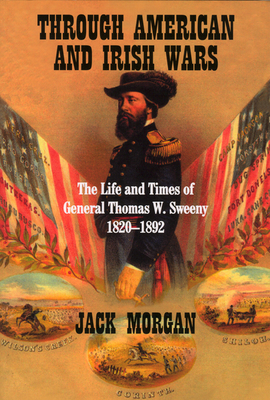Through American and Irish Wars
Peter Berresford Ellis reviews Through American and Irish Wars: the Life and Times of General Thomas W. Sweeny 1820-1892 by Jack Morgan (foreward by Dr Ruán O'Donnell), Irish Academic Press, ISBN 0 7165 3324 3, £19.50/€25 pbk

THOMAS SWEENY, as a twelve-year-old, emigrated from his Co Cork home with his family in 1832 and settled in Brooklyn, New York. After working as a compositor, he joined the US army at the start of the US-Mexican War and soon distinguished himself. As a lieutenant he was badly wounded and had his right arm amputated during the Battle of Churubusco in 1847.
He remained in the army and during the American Civil War, was twice wounded, rising to the rank of Brigadier General and playing a notable role in the Battle of Corinth and at Shiloh. He commanded a brigade under General Lew Wallace and later a division of the XVI Corps during Sherman's campaign against Atlanta.
Yet throughout his life he was devoted to the cause of Irish self-determination and became a member of the Irish Republican Brotherhood. 'Fighting Tom' Sweeny became an advocate of a plan adopted by the IRB to use the tens of thousands of Irish soldiers, veterans of the Union and Confederate armies, who had joined the IRB. The IRB (Fenians) would invade the provinces of British North America, and occupy them to use as a bargaining chip to persuade the British to leave Ireland.
Tom Sweeny was designated the IRB's 'secretary for war' and his was the battle plan that was to launch a three-pronged attack on Ontario and Quebec consisting of a projected total of 25,000 men. The aim was two diversionary attacks while the main army made for Montreal, meet up with French-Canadian sympathisers, and secure the seaports along the St Lawrence, bringing in ex-US Navy warships purchased by the IRB.
The politics that went into the failure of the invasion plan, Sweeny's final retirement and his death in 1892, make for a fascinating story.
Historians have usually adopted the British propaganda view of the event - a crazed idea by a group of drunken Irishmen that didn't stand a chance. Yet it was as a result of this event that the British provinces united as the Dominion of Canada.
Thankfully, Dr Morgan presents a considered and competent biography of this famous son of Cork and puts the invasion in its proper historical context.
Back in the 1980s I published several academic papers on the invasion in The Irish Sword and in Canadian publications, one in collaboration with Dr Joseph A. King (none of which have been acknowledged by Dr Morgan,) which led to my presentation of the events in a novel The Rising of the Moon (1987). I actually grew up with the story of General Sweeny. An ancestor, Nicholas Ellis, left Cork City in 1861 and went to Louisville where he joined the 20th Regiment of Kentucky Infantry in the Union army. Among other battles he served at was Corinth and Shiloh. He left the Union Army in 1865 as a First Sergeant. By that time he had joined Col. George Owen Starr's 17th Regiment of the IRB and then took part in the crossing into Niagara in 1866. He returned to Cork in 1869.
A few research oversights apart, this biography of Sweeny is very welcome. Yet there is still much to be written on the Fenian invasion of Canada, which continues to be disgracefully distorted in history. I tracked down the only known surviving IRB uniform captured in the invasion to the Royal Artillery Museum in Greenwich the late 1980s. The Museum put it up for sale. The National Museum of Ireland was not even interested and it was bought by a Canadian museum. Need one say more?
Connolly Association, c/o RMT, Unity House, 39 Chalton Street, London, NW1 1JD
Copyright © 2006 Peter Berresford Ellis

